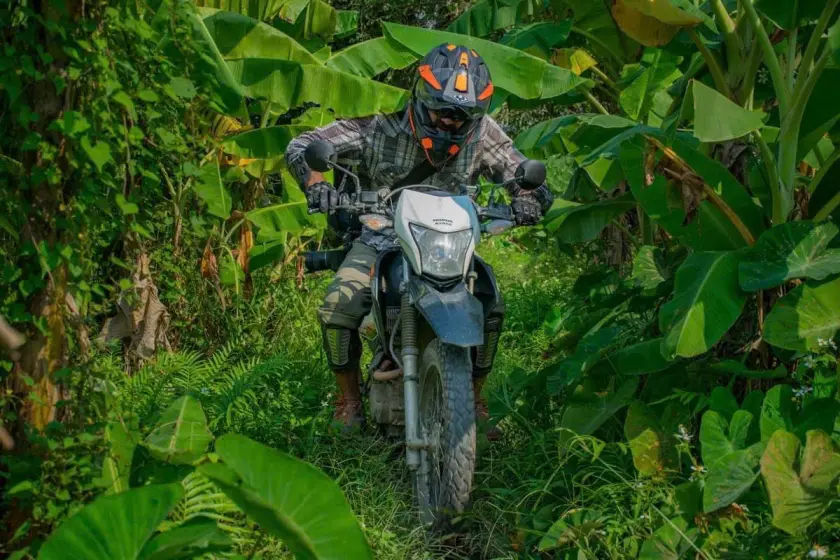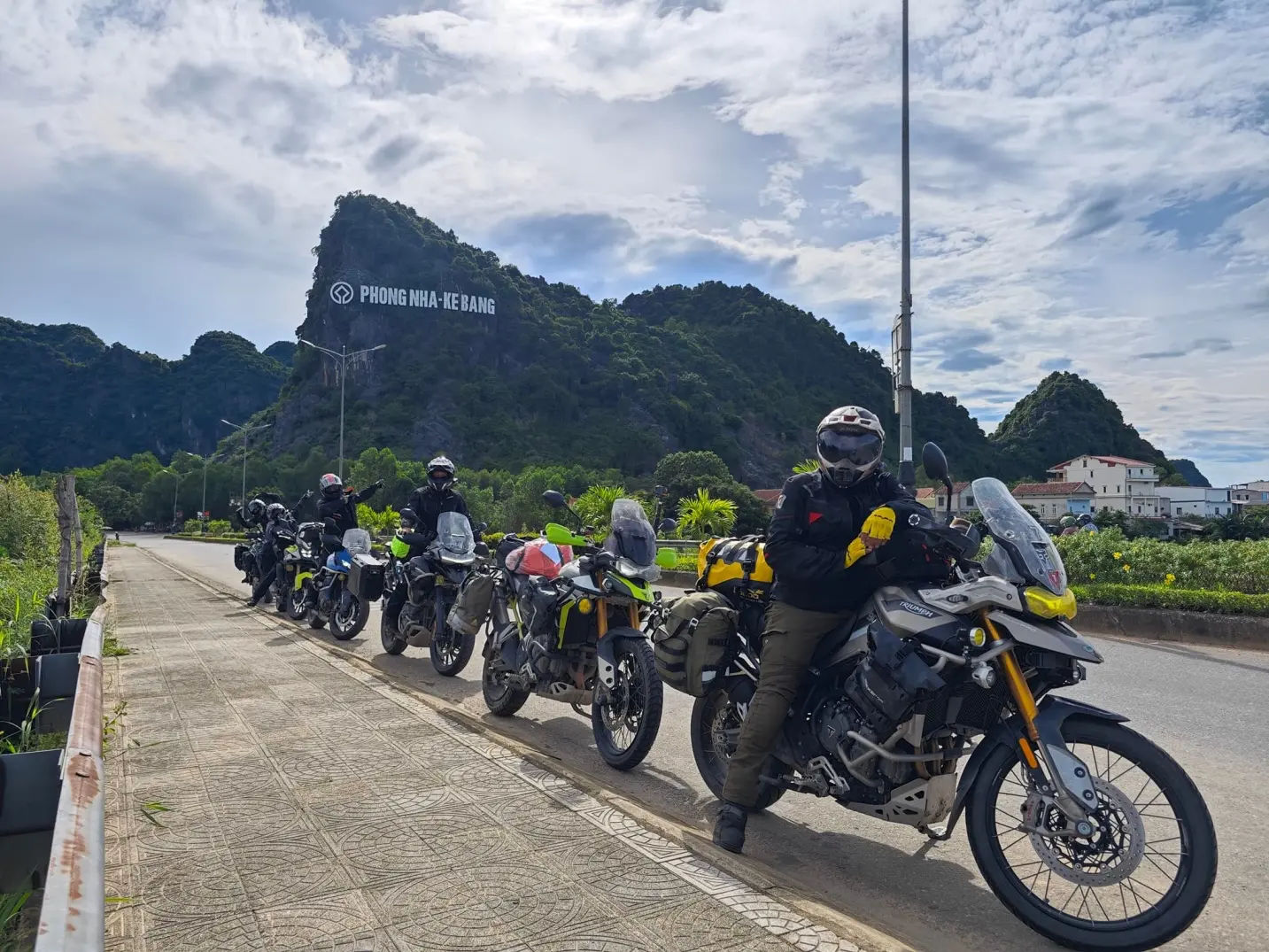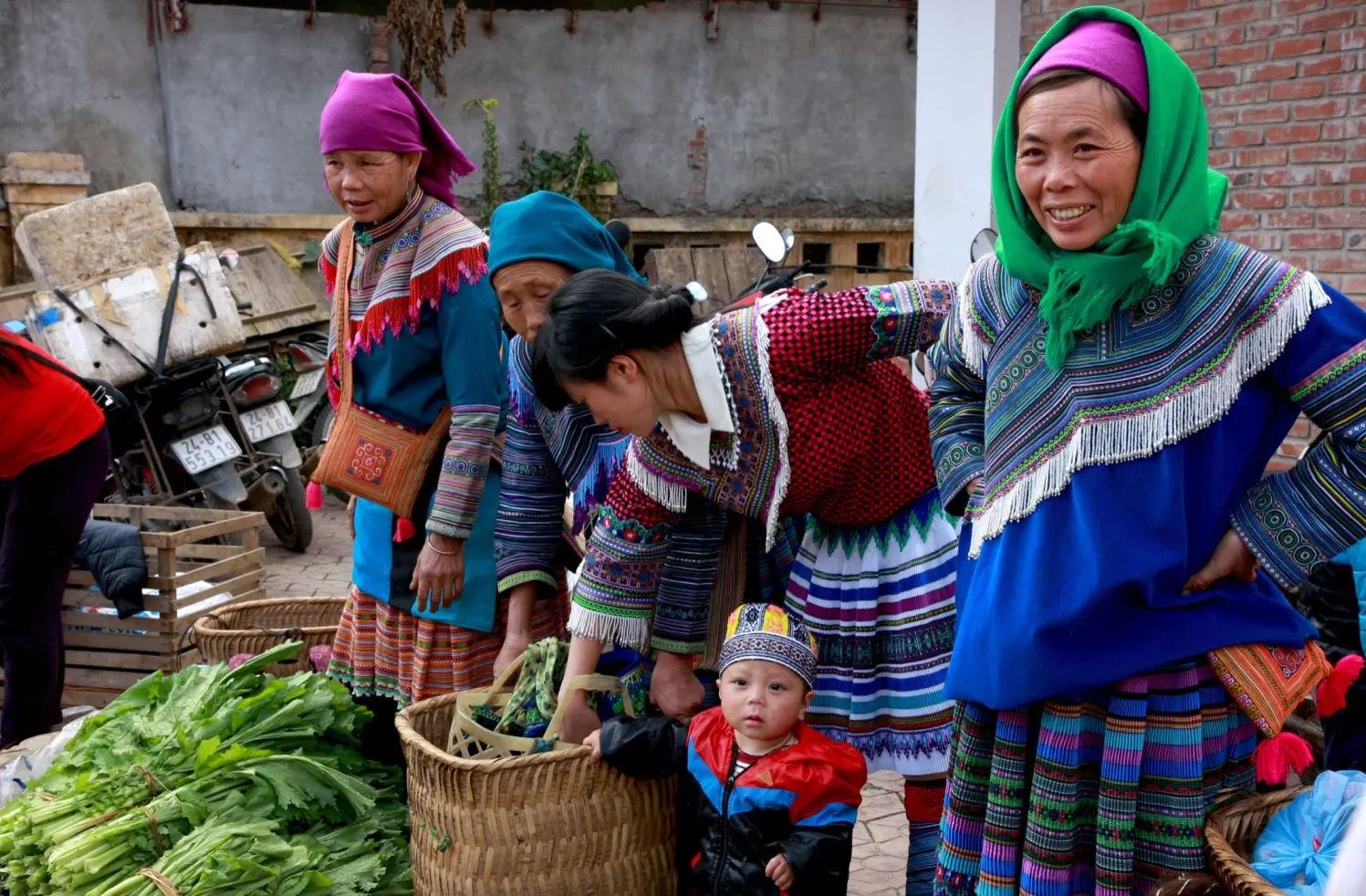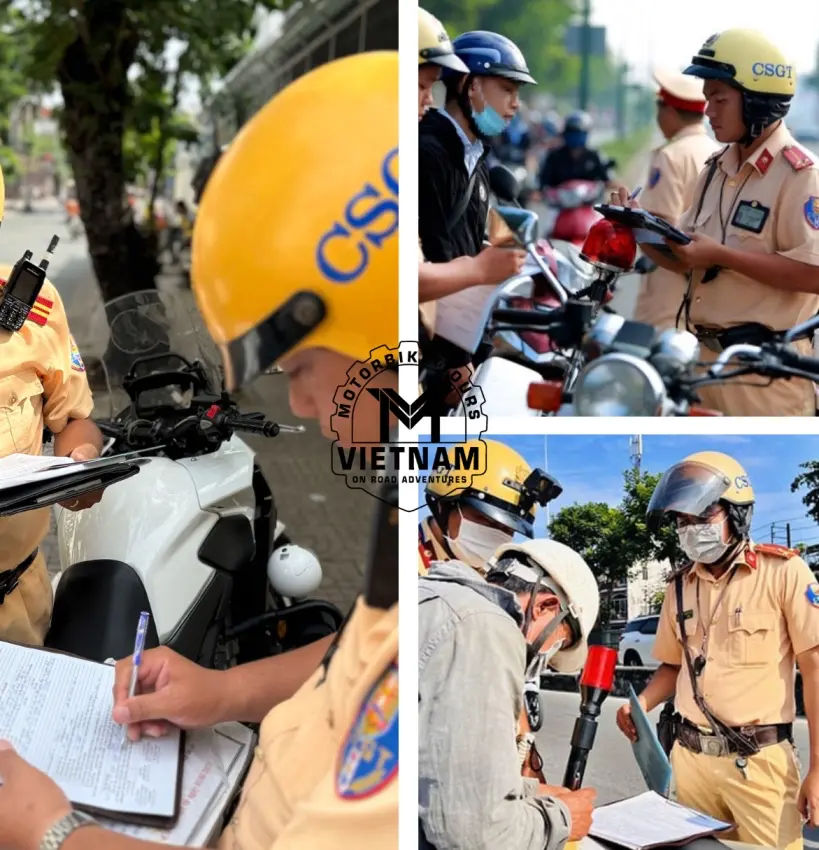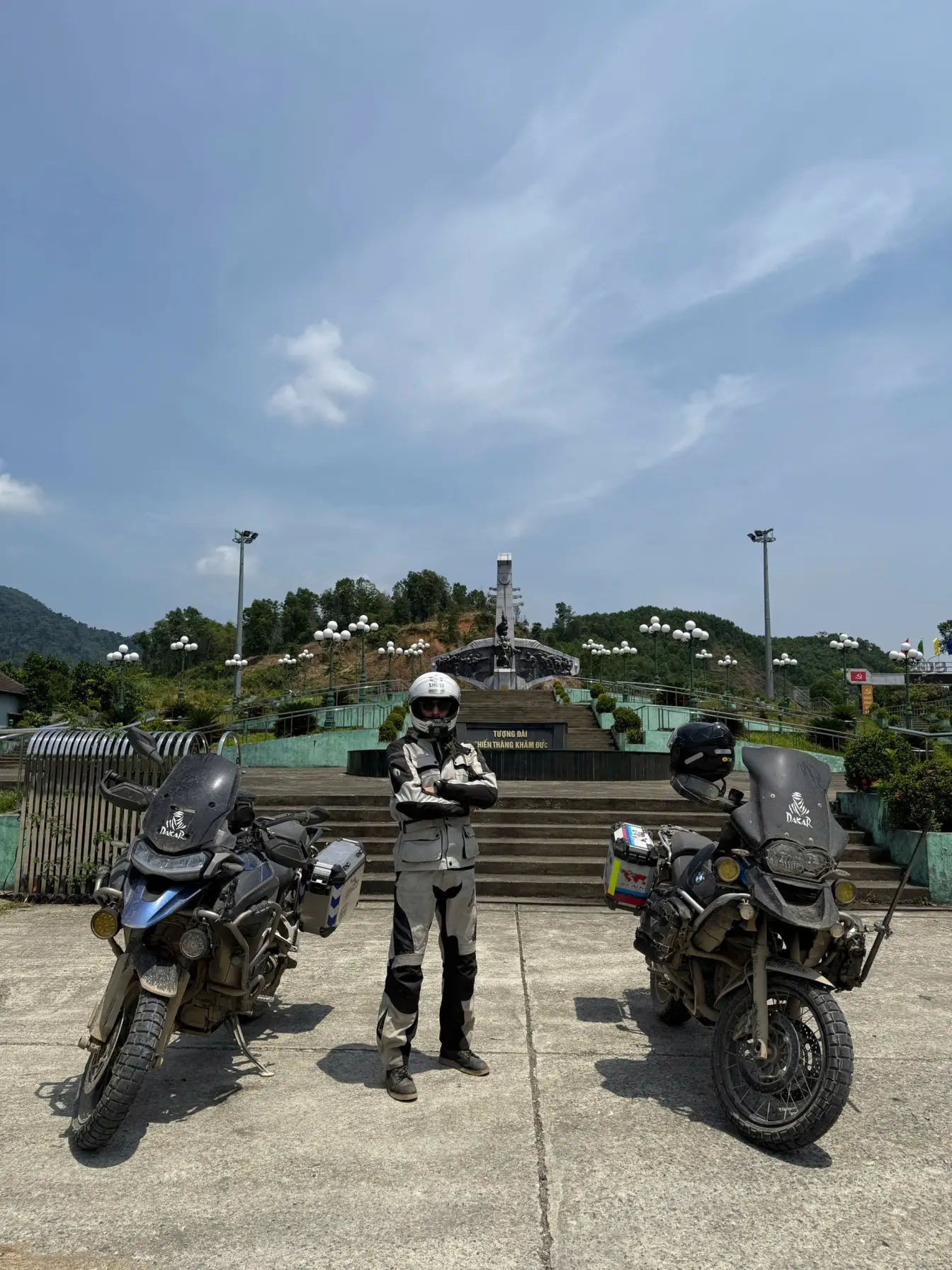
Popular motorbike routes, either to choose for a tour around, or plan it for a self-ride, include the challenging northern Vietnam that captures riders with its wild beauty, sharp limestone peaks, and curving passes, and remote villages along the Ha Giang Loop. Longer adventures on the Central North Loop or routes toward Ban Gioc Waterfall and Ta Xua’s Dinosaur Spine promise mountain drama and cultural depth. Central and Coastal Vietnam bring a different rhythm with lush jungles and ocean views; the Hai Van Pass as a highlight and stretches of the Ho Chi Minh Trail between Khe Sanh and Phong Nha are unforgettable rides. Around Hue and Da Nang, smaller loops reveal quiet lagoons and backroads few travelers see. Southern Vietnam offers with smoother rides and warmer air especially the Da Lat to Nha Trang descent through pine forests and waterfalls.
- Check out our best Vietnam motorcycle tours
Introduction to Motorbike Touring in Vietnam
There’s no better way (at least t riders like myself) to experience Vietnam than on a well-planner motorcycle trip. Riding in here isn’t just for a transportation, it’s an adventure that unfolds at your own pace, where every turn brings a new landscape, flavor, or friendly smile. The roads wind through misty mountain passes, sleepy fishing villages, and rice fields that shimmer under the sun.
You’ll find yourself stopping for bowls of steaming pho noodle soup at a roadside stall, chatting with curious locals, and soaking in views you’d miss on a tour bus. Whether you’re cruising along the coast or navigating the highlands, Vietnam rewards every kilometer with raw, unfiltered beauty.
Why Vietnam is a Dream Destination for Riders
Why? well, Vietnam feels like it was built for motorbikes, seriously, the country’s long, slender shape means endless variety, one day you’re climbing the cloud-covered mountains of Cao Bang to Sapa, the next few days you’re following the turquoise coastline near Da Nang. Fuel is cheap, mechanics are everywhere, and even the smallest villages have a place to grab a coffee or fix a flat tyre.
Locals often wave or chat as you pass by, and it’s easy to find community among fellow travelers on the road. Every region tells its own story, and a motorbike lets you hear them all up close and personal, at the perfect speed to soak it in.
Best Time of Year for Motorbike Travel
Choosing the right season can make or break your Vietnam ride, well, may of our riders often say, that’f fine if its raining or foggy in the mountains, we love the off-road, more muddy trails and more adventure. In the north, the best months are September to November and March to May, when the weather is cool and clear, ideal for the Ha Giang Loop or mountain routes near Sa Pa.
The central coast shines between February and August, offering dry days for tackling the Hai Van Pass or cruising along the Ho Chi Minh Trail. Down south, around Da Lat and the Mekong region, conditions stay warm year-round, though afternoon showers are common from May to October. Many seasoned riders plan their routes to follow the sunshine, chasing Vietnam’s shifting seasons from north to south.
- Check out when is the best month for Ha Giang Loop
- The best and worst months to visit Vietnam in general
| Route | Region | Typical duration | Key roads & backroads | Highlights | Best months |
|---|---|---|---|---|---|
| Ha Giang Loop | Northern Vietnam | 3–5 days (short); 7–10 days (slow pace) | QL4C, QL34, provincial roads through Yen Minh, Dong Van, Meo Vac; Ma Pi Leng | Karst peaks, ethnic Hmong/Tay villages, Ma Pi Leng Pass, Dong Van Karst Plateau | Sep–Nov, Mar–May |
| Hai Van Pass (Hoi An ↔ Hue / Da Nang) | Central & Coastal | Half day to 1 day | Highway 1A, Hai Van Pass road, pullouts overlooking Da Nang Bay | Ocean views, French-era bunkers, Lang Co Lagoon | Feb–Aug |
| Hanoi → Ho Chi Minh City (via Ho Chi Minh Trail) | North → South / Cross-country | 2–4 weeks | Highway 1A; QL15, QL14; Ho Chi Minh Highway; backroads to Phong Nha, Khe Sanh | Varied landscapes, wartime sites, Phong Nha-Ke Bang, remote villages | Oct–Apr (varies by region) |
| Central Loop (Hue ↔ Da Nang) | Central & Coastal | 1–3 days | Provincial roads near Lang Co, coastal lanes, routes to tombs & lagoons | Quiet beaches, imperial tombs, low-traffic countryside | Feb–Aug |
| Da Lat → Nha Trang | Central Highlands → Coast | Half day to 1 day | QL27C (Khanh Le Pass), Hon Giao road, detours to Yang Bay | Pine forests, waterfalls, cool-to-coast climate change | All year (best Nov–Apr) |
| Mekong Delta Route | Southern Vietnam | 2–5 days | QL60, DT884, small provincial roads, ferries between islands | Floating markets, canals, orchards, easy riding | Dec–Apr |
Top Motorbike Routes Across Vietnam
The motorbike routes in Vietnam are legendary for good reason, each one feels like its own story. The northern mountains challenge even seasoned riders with dizzying passes and remote ethnic villages as a surprise, while the central coast delivers cinematic scenery straight out of a travel magazine. Heading south, the highlands open up into cool pine forests and waterfalls before spilling into the river-laced Mekong Delta.
Whether it’s a few days looping through rugged terrain or a full cross-country journey, these routes blend scenery, culture, and freedom in a way that only Vietnam can.
- Check out a popular ride: 15 day tour across Vietnam from North to the South
Ha Giang Loop (The Northern Mountain Adventure)
The Ha Giang sits at the very top of Vietnam and feels like another world. Starting from Ha Giang City (best to do it from Hanoi), most riders follow a counterclockwise loop through Yen Minh, Dong Van, and Meo Vac, returning via Mau Due.
The road hugs jagged cliffs above deep green valleys, twisting through the Dong Van Karst Plateau Geopark, where limestone peaks rise like stone waves. You’ll pass through ethnic minority villages such as Hmong, Tay, and Lo Lo, where kids wave as you ride by.
The Ma Pi Leng Pass between Dong Van and Meo Vac is the crown jewel: 20 kilometers of breathtaking curves overlooking the Nho Que River far below. Three to five days gives enough time to explore, but it’s the kind of road that makes you wish you never had to turn back.
- Check out lesser-known alternatives for Ha Giang
Hoi An to Hue via Hai Van Pass (Ocean of Clouds)
Few roads capture Vietnam’s coastal drama like the Hai Van Pass, a stretch of Highway 1A between Hoi An, Da Nang, and Hue. It’s just 21 kilometers long, but its winding ascent over misty ridges makes it unforgettable.
Riders often start in Hoi An, follow Vo Nguyen Giap Road north along the beaches, then climb into the mountains where the air turns cool and salty. The old French bunkers at the summit offer panoramic views over Da Nang Bay, while the descent toward Hue reveals lagoons, fishing villages, and rice paddies that glow at sunset. It’s best done in the dry months—February to August—with a coffee stop at Lang Co Lagoon to watch the world go by before continuing toward Hue’s imperial streets.
Ho Chi Minh Trail (A ride through the war trail)
The Ho Chi Minh Trail is the ultimate long-distance ride, weaving through Vietnam’s spine from north to south. Much of it follows Ho Chi Minh Highway (QL15 and QL14), passing jungle valleys, remote towns, and remnants of the war years.
The section between Phong Nha and Khe Sanh is especially stunning & smooth, empty tarmac winding through dense forests and limestone cliffs near Phong Nha-Ke Bang National Park.
Along the way, you’ll find quiet rest stops in Pheo, A Luoi, or Kham Duc, where homestays welcome dusty riders with a hot meal and a cold beer. It’s not just about the scenery; it’s a road that breathes history, echoing the stories of those who once crossed it on foot, long before the hum of motorbikes filled the air.
Da Lat to Nha Trang – Central Highlands to Coast
Riding from Da Lat to Nha Trang feels like traveling through two different country even teh distance is less than 200km. Leaving Da Lat, the road QL27C, known locally as the Khanh Le Pass, winds through pine forests, flower farms, and mountain mist before dropping sharply toward the coast.
The air warms as you descend, revealing waterfalls like Yang Bay and Cam Duc’s rolling hills, before the sea finally appears in a burst of blue near Nha Trang. The 140-kilometer ride can be done in half a day, but most riders linger, stopping at small cafes in Hon Giao or taking short detours to local villages. It’s a route that perfectly captures Vietnam’s contrasts: cool highland calm meeting coastal energy in one continuous, thrilling descent.
Mekong Delta Route – Exploring the Southern Charm
The Mekong Delta ride trades mountains for waterways and rice fields, offering a gentler rhythm. Starting from Ho Chi Minh City, riders head toward My Tho, then weave through Ben Tre, Can Tho, and Chau Doc, following smaller roads like QL60 and DT884 that cut between palm-lined canals and fruit orchards. Ferries connect tiny islands, and the hum of engines mixes with the sound of boats gliding past.
Locals wave as you cross bamboo bridges, and you’ll find endless excuses to stop for fresh coconut or grilled fish by the roadside. The ride is flat and easy, but it’s rich in life—the kind of place where you trade speed for smiles and every turn leads to another unexpected encounter.
Essential Tips for Riding a Motorbike in Vietnam
Riding across Vietnam is very unique for so many different reasons, but it’s also demanding, especially if it’s your first time handling a motorbike in Asia. Between mountain switchbacks, chaotic city streets, and hidden backroads, being prepared makes all the difference.
Choosing the right bike, carrying the right documents, and understanding local road manners can turn a nerve-wracking journey into the trip of a lifetime. These are lessons learned the hard way after flat tires in the middle of nowhere, coffee stops with curious villagers, and long stretches of road that remind you how vast and wild Vietnam really is.
Choosing the Right Motorbike
The right motorbike depends on how far you plan to go and where. For short coastal trips, a 110–125cc scooter like the Honda Vision or Yamaha Nouvo is more than enough easy to ride, fuel-efficient, and fixable anywhere. But if you’re tackling mountain passes like Ha Giang or long-distance routes such as the Ho Chi Minh Trail, you’ll want something sturdier like a Honda XR150 or Yamaha Exciter.
Many riders buy used bikes in Hanoi or Ho Chi Minh City, travel the country, and sell them at the other end. Always check the brakes, tires, and lights before setting off, and carry basic tools for quick roadside fixes Vietnamese mechanics can work miracles, but only if you can roll your bike to the next village.
Documents and Licenses Needed
Paperwork may not be the most exciting part of your trip, but it’s crucial. To ride legally in Vietnam, you’ll need a Vietnamese driving license or an International Driving Permit (IDP) based on the 1968 Vienna Convention, the older 1949 version isn’t recognized.
Many travelers still ride without one, but police checks, especially in cities and the north, are becoming more frequent. It’s also smart to carry your passport, motorbike blue card (registration), and travel insurance that covers motorbike accidents. When renting, make sure the shop gives you a copy of the ownership papers. Police are usually friendly if you’re polite, but having the right documents can save you hours of explaining on the roadside.
Road Conditions and Safety Tips
Vietnam’s roads range from smooth highways to gravel mountain tracks that test every bit of your balance. Expect potholes, wandering livestock, and the occasional surprise like a bus overtaking another bus on a blind corner.
Keep your speed moderate and your horn ready; it’s used more for communication than anger here. In rural areas, roads can vanish under landslides during the rainy season (May to October in the north), so always check the weather before you ride. Locals often know which sections are washed out, so don’t hesitate to ask.
A good helmet, gloves, and jacket make a huge difference, especially in the mountains where temperatures drop fast after sunset.
Navigation and Local Etiquette
Even with Google Maps or Maps.me, don’t underestimate the value of local advice. Villagers are quick to point out better backroads or warn about flooded paths, often drawing maps in the dust or gesturing down the right lane.
Vietnam’s traffic flows like water steady but chaotic—so watch how locals merge and move before you join in. Use your horn lightly to signal presence, keep to the right, and never assume anyone sees you. When stopping in small towns, park respectfully, remove your helmet when entering shops, and always greet people with a smile. The more you blend in with local rhythms, the more rewarding every ride becomes.
Recommended Motorbike Tour Companies in Vietnam
While riding solo in Vietnam offers unmatched freedom to so many riders, joining a motorbike tour can take the stress out of planning and open doors to places you might never find on your own plus riding premium bikes that you won’t be able to rent if you ride solo.
Local tour companies know the mountain shortcuts, scenic detours, and the best roadside stalls for a hot bowl of pho after a long day on the road. Whether you’re after a fully guided expedition through Ha Giang or a self-drive tour with support along the Ho Chi Minh Trail, Vietnam has operators who know how to balance safety, adventure, and authentic local experiences.
Guided Tours vs Independent Travel
Choosing between a guided tour and independent travel depends on your confidence, time, budget and what you want out of the trip. Guided tours are perfect for riders who want to focus on the scenery, not the logistics routes, permits, and accommodation are all handled, and local guides often double as storytellers, translators, and mechanics.
It’s also safer in remote areas like Ha Giang, where checkpoints require special permits. Independent travel, on the other hand, gives you complete freedom to change direction whenever the road tempts you whether it’s following a dirt track into the hills near Phong Nha or extending your stay in Da Lat. Both styles have their magic; one offers structure and camaraderie, the other, pure spontaneity.
Top-Rated Local Tour Operators
Several Vietnamese tour companies have built strong reputations among riders for their local knowledge, reliable bikes, and responsible travel ethos. In the north, choose a reputable company that offer popular routes plus tailor-made planning for the northern loops around Dong Van or Meo Vac. There are a handful of (less than 10) operators offering stunning trips across country’s amazing trails.
Additionally, there are a few rental shops that also offer motorbike tours to pre-designed event riders suitable for those interested in a group ride. Anyway, for a mix of comfort and adventure, with right motorcycle based on your budget, choose an organizer that offer them as a package. Many tours can be customized for solo riders, couples, or small groups, making it easy to find your perfect balance of adventure and support on the open road.
Accommodation and Food Along the Routes
Part of the joy of motorbiking through Vietnam is where you stop, not just where you ride. From mountain homestays overlooking rice terraces to roadside guesthouses beside the sea, the country is full of simple but welcoming places to rest.
Most towns along popular routes like Ha Giang, Phong Nha, or Da Lat have budget-friendly nha nghi (local guesthouses) that cater to riders.
Meals are rarely far away small family-run eateries serve hearty soups, grilled meats, and fresh vegetables at any hour. After a long day on the road, nothing beats pulling up, parking your bike, and sharing a meal with locals who’ve seen hundreds of riders come and go.
Homestays and Local Guesthouses
Homestays have become a highlight of riding in Vietnam, especially in northern and rural regions where there isn’t many modern hotels. In Dong Van or Mai Chau, you can sleep in stilt houses overlooking valleys, waking to the sound of roosters and children heading to school.
Hosts often serve home-cooked meals sticky rice, sautéed greens, and homemade corn wine around a communal table where travelers swap stories from the road. In smaller towns, guesthouses (nha nghi) are basic but reliable, usually offering clean rooms, a fan or air-con, and safe parking for your bike. You’ll rarely need to book in advance unless it’s a public holiday, and many owners double as impromptu guides, suggesting scenic routes or hidden local spots worth the detour.
Must-Try Vietnamese Dishes for Riders
Tell you one thing, the foods are vary from city to city and across the country. Each region brings its own flavors, and the best meals are often found at unassuming roadside stalls.
In the north, don’t miss pho bo (beef noodle soup) and thang co, a hearty highland stew.
Along the central coast, try mi Quang in Da Nang, bun bo Hue in Hue, or fresh seafood grilled right by the beach.
Down south, fuel up on com tam (broken rice with pork) and hu tieu (noodle soup) in the Mekong Delta. Coffee stops are a daily ritual—strong, sweet, and best enjoyed while watching the road buzz by. Many riders joke that the food alone is reason enough to cross the country twice.
Challenges and How to Overcome Them
Even for seasoned riders, Vietnam’s roads demand patience, preparation, and a good sense of humor.
The country’s beauty comes hand-in-hand with unpredictable weather, wild terrain, and the occasional mechanical hiccup in the middle of nowhere. Every challenge is part of the adventure, though something every rider learns between downpours and dusty climbs. Knowing how to adapt, who to ask for help, and when to slow down can turn a potentially stressful moment into one of the most memorable parts of your trip.
Weather and Terrain Considerations
Vietnam’s geography means the weather can change dramatically from one region to the next.
In the north, the mountains around Ha Giang and Sapa can be misty and cold between December and February, while heavy rains may hit from June to August, making landslides and slippery passes common. Central Vietnam sees typhoons from September to November, though the Hai Van Pass remains stunning on clear days. In the south, afternoon showers are frequent during the rainy season but rarely last long.
The best approach is flexibility if a storm rolls in, find shelter in a cafe or guesthouse, wait it out, and chat with locals. A lightweight rain jacket, waterproof bags, and good tires will keep most problems minor.
Dealing with Breakdowns and Emergencies
Every long ride in Vietnam comes with at least one mechanical story. Maybe a flat tire outside Meo Vac, or a sputtering engine halfway to Phong Nha. Fortunately, help is never far away.
Small roadside repair shops (sửa xe máy) dot every highway and village, and local mechanics are famously resourceful often fixing issues with little more than basic tools and a smile. Carry a small repair kit, spare tube, and know how to tighten your chain or replace a spark plug. In remote areas, locals will almost always lend a hand or point you to the nearest mechanic.
Keep emergency cash, and store key numbers like your rental company or tour operator in your phone. With patience and a bit of resourcefulness, most breakdowns turn into road stories you’ll be telling for years.
Conclusion: The Ultimate Freedom of Motorbike Touring in Vietnam
There’s something deeply addictive about riding a motorbike through Vietnam, the sense of freedom, the unpredictability, and the quiet moments between the chaos.
You feel every change in the landscape, from cool mountain mist in Ha Giang to the salty air rolling off the Hai Van Pass, to the warm breeze of the Mekong Delta.
Every day on the road brings something new: a local waving you down for tea, a rainstorm that forces you to take shelter in a stranger’s home, a hidden waterfall you find by accident. It’s travel stripped to its core immediate, raw, and personal.
About the author
Hamid is an avid adventure rider who has spent years exploring Vietnam’s backroads, from the misty highlands of Ha Giang to the palm-lined trails of the Mekong Delta. Riding both solo and with local rider groups, he documents real-world experiences, route insights, and on-the-road tips for fellow travelers seeking authentic motorbike adventures. His firsthand journeys add local depth and rider-tested knowledge to every guide he writes, ensuring accuracy and reliability for anyone planning their own Vietnam road trip.




